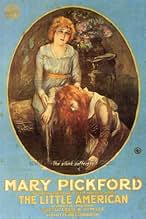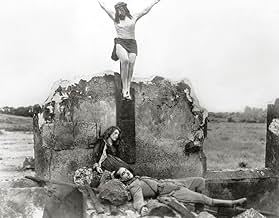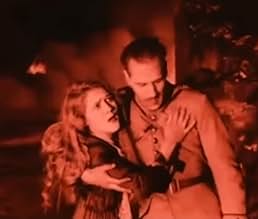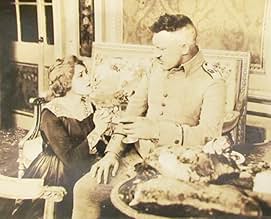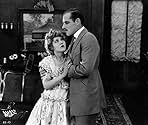Adicionar um enredo no seu idiomaA young American has her ship torpedoed by a German U-boat but makes it back to ancestral home in France, where she witnesses German brutality firsthand.A young American has her ship torpedoed by a German U-boat but makes it back to ancestral home in France, where she witnesses German brutality firsthand.A young American has her ship torpedoed by a German U-boat but makes it back to ancestral home in France, where she witnesses German brutality firsthand.
- Direção
- Roteiristas
- Artistas
Wallace Beery
- German Soldier
- (não creditado)
Olive Corbett
- Nurse
- (não creditado)
Lucile Dorrington
- Nurse
- (não creditado)
Clarence Geldert
- Submarine Commander U-Boat 21
- (não creditado)
Carl Gerard
- Reverend
- (não creditado)
Robert Gordon
- Wounded Soldier
- (não creditado)
Gordon Griffith
- Child
- (não creditado)
Avaliações em destaque
With the Great War ravaging Europe as this film was made, it's a clear signal of patriotism from star Mary Pickford as she depicts the feisty "Angela". She's from wealthy stock and on her birthday is being courted by French "Count Jules" (Raymond Hatton) and by her slight favourite, the Prussian soldier "Karl" (Jack Holt). Before she has to make any choices, though, both head to their respective homes to fight. Shortly thereafter, she decides to travel to her aunt's home in France only for her liner to be torpedoed and for her to find that when she eventually arrives at her stately pile that the Bosch are intent on billeting there and behaving abominably too. Her American status gives her a degree of protection so long as she stays out of the conflict, and her stiff-necked friend "Karl" is amongst the occupiers, but when their cruelty to the house's staff and to an elderly gent shock her to the core, she decides that she can no longer stay on the fence. What now ensues sees her bravely attempt to help the Allied forces at great peril not just to her, but to her friend who would try to keep her as alive as his upbringing would permit! That merely invites a trial for espionage and treason and a firing squad for both of them looms... Can they find a way to escape the bullets? This is an effective propaganda tool, this film, illustrating just how ghastly the enemy were; how indiscriminate their violence was inflicted and how generally boorish and superior they were. Pickford and Cecil B. DeMille clearly wanted to ram that point home to domestic audiences and on that front they are quite effective. It really could have done with some more light, but even dingy as it is it delivers quite a potent analysis of uniformed thuggery tempered by conflicted romance and a semblance of human decency. It has it's zealous moments - from all sides, and in it's way it is quite a tough film to watch as though not graphic in terms of photography, it is in terms of psychology. It has a clear message to send and is worth a watch, I'd say.
America entered World War One in April 1917 after almost three years of brutal fighting between England, France and their allies and Germany and its alliance. The first Hollywood so-called propaganda film released soon after Congress declared war on Germany and the Central Powers was Cecil B. DeMille's July 1917 "The Little American," starring Mary Pickford.
Its director DeMille had lost a good friend in the sinking of the Lusitania by a German submarine two years earlier, while Canadian Pickford had seen her native country involved in the war since 1914. Both were ardent supporters of the United States' war effort, and both eagerly participated in a movie that painted the Germans simply as barbarians. The Chicago Board of Censors, in fact, was so concerned about the city's large German-American population that it banned the movie from being shown. Two court rulings eventually overturned the censor board's prohibition from exhibiting "The Little American."
The Jeanne McPherson script does soften the anti-German edges somewhat by creating a young German residing in America as a paramour to Pickford. Karl Von Austreim, played by Jack Holt, is summoned by Germany in the fall of 1914 to join his regiment in Europe. The two lovers depart, only to once again meet on the battlefields of the Western Front. She's seen nursing several injured French soldiers after visiting her aunt in France, who had just died of natural causes near the fighting. Pickford ends up becoming a spy for the French, pinpointing important German artillery on her aunt's property. It is there she meets her old boyfriend, and he ends up becoming a protector for her.
While the film is praised for its recreation of a British liner's sinking by German hands, of which Pickford's character was a passenger, the movie failed to garner the enormous profits for the Mary Pickford Company, through its distribution branch Aircraft Pictures. This is the second and final picture DeMille directed with the popular actress. The first, released a couple months before in "A Romance of the Redwoods," was studio head Adolph Zukor's solution for a career correction for Pickford after viewing the preview of her last film, "The Poor Little Rich Girl." He saw the movie as being a total dud. Despite the actress having a clause in her contract giving her total control over her productions, Zukor felt DeMille's steady, serious hand would straighten her out. Of course "The Poor Little Rich Girl" ended up an enormous hit, and she would revert back to playing a kid again in her next two movies after "The Little American." To be fair, "Redwoods," on the basis of Pickford's star power, became the fourth highest grossing movie of the year.
Meanwhile, the two movies with DeMille spelled doom for her ongoing, unhappy marriage to actor Owen Moore, as well as making it easier in her clandestine romance with Douglas Fairbanks, whom she had met two years earlier at a Tarrytown, N. Y. party. The filming locations of "Redwoods" and "American" took place in southern California, where the married Fairbanks resided. Pickford had been living near her studio in Ft. Lee, N. J. before relocating out West. She would never live in the East ever again.
Returning to "A Little American:" Even a MacPherson script, co-written by DeMille, couldn't quite rescue "A Little American." MacPherson and the director formed one of the more successful and influential working partnerships in Hollywood. As an actress as well as a minor director and scriptwriter, she approached DeMille for an acting job in 1914. Instead, the director, realizing her scenario talents, hired her as a screenwriter. She went on to write 30 of DeMille's first 34 movie scripts, with her last screenplay for the director in 1930's "Madam Satan."
Its director DeMille had lost a good friend in the sinking of the Lusitania by a German submarine two years earlier, while Canadian Pickford had seen her native country involved in the war since 1914. Both were ardent supporters of the United States' war effort, and both eagerly participated in a movie that painted the Germans simply as barbarians. The Chicago Board of Censors, in fact, was so concerned about the city's large German-American population that it banned the movie from being shown. Two court rulings eventually overturned the censor board's prohibition from exhibiting "The Little American."
The Jeanne McPherson script does soften the anti-German edges somewhat by creating a young German residing in America as a paramour to Pickford. Karl Von Austreim, played by Jack Holt, is summoned by Germany in the fall of 1914 to join his regiment in Europe. The two lovers depart, only to once again meet on the battlefields of the Western Front. She's seen nursing several injured French soldiers after visiting her aunt in France, who had just died of natural causes near the fighting. Pickford ends up becoming a spy for the French, pinpointing important German artillery on her aunt's property. It is there she meets her old boyfriend, and he ends up becoming a protector for her.
While the film is praised for its recreation of a British liner's sinking by German hands, of which Pickford's character was a passenger, the movie failed to garner the enormous profits for the Mary Pickford Company, through its distribution branch Aircraft Pictures. This is the second and final picture DeMille directed with the popular actress. The first, released a couple months before in "A Romance of the Redwoods," was studio head Adolph Zukor's solution for a career correction for Pickford after viewing the preview of her last film, "The Poor Little Rich Girl." He saw the movie as being a total dud. Despite the actress having a clause in her contract giving her total control over her productions, Zukor felt DeMille's steady, serious hand would straighten her out. Of course "The Poor Little Rich Girl" ended up an enormous hit, and she would revert back to playing a kid again in her next two movies after "The Little American." To be fair, "Redwoods," on the basis of Pickford's star power, became the fourth highest grossing movie of the year.
Meanwhile, the two movies with DeMille spelled doom for her ongoing, unhappy marriage to actor Owen Moore, as well as making it easier in her clandestine romance with Douglas Fairbanks, whom she had met two years earlier at a Tarrytown, N. Y. party. The filming locations of "Redwoods" and "American" took place in southern California, where the married Fairbanks resided. Pickford had been living near her studio in Ft. Lee, N. J. before relocating out West. She would never live in the East ever again.
Returning to "A Little American:" Even a MacPherson script, co-written by DeMille, couldn't quite rescue "A Little American." MacPherson and the director formed one of the more successful and influential working partnerships in Hollywood. As an actress as well as a minor director and scriptwriter, she approached DeMille for an acting job in 1914. Instead, the director, realizing her scenario talents, hired her as a screenwriter. She went on to write 30 of DeMille's first 34 movie scripts, with her last screenplay for the director in 1930's "Madam Satan."
According to his autobiography The Little American is the film that Cecil B. DeMille wanted to make with Mary Pickford. Both were strong supporters of the Allied cause in World War I. But Adolph Zukor wanted a box office draw with a western so A Romance Of The Redwoods was done first. DeMille envisioned The Little American as part of his contribution to the propaganda war effort. And Pickford was well known for her bond tours with her husband Douglas Fairbanks.
The Little American has Mary Pickford a daughter of the a US Senator and being courted by two men, German-American Jack Holt who receives orders to return to the Fatherland for an officer's commission in the newly declared war and French diplomat Raymond Hatton similarly ordered home. Pickford's family has a château in France and she travels there to be a nurse. But her ocean liner is torpedoed like the Lusitania and she eventually gets there.
But as it turns out the château is in German occupied territory and she's asked to do a little espionage. And who do you think is among the Germans occupying, none other than Holt.
As this was a film that DeMille himself labels a contribution to the war effort a lot of it can be dismissed. Pickford was her heroic best as The Little American. Some aspects of the real life Edith Cavell story are incorporated here with a lot more happy ending.
As for the German atrocities. They'd have to wait until the next war when Hollywood couldn't make up what they did in real life.
The Little American has Mary Pickford a daughter of the a US Senator and being courted by two men, German-American Jack Holt who receives orders to return to the Fatherland for an officer's commission in the newly declared war and French diplomat Raymond Hatton similarly ordered home. Pickford's family has a château in France and she travels there to be a nurse. But her ocean liner is torpedoed like the Lusitania and she eventually gets there.
But as it turns out the château is in German occupied territory and she's asked to do a little espionage. And who do you think is among the Germans occupying, none other than Holt.
As this was a film that DeMille himself labels a contribution to the war effort a lot of it can be dismissed. Pickford was her heroic best as The Little American. Some aspects of the real life Edith Cavell story are incorporated here with a lot more happy ending.
As for the German atrocities. They'd have to wait until the next war when Hollywood couldn't make up what they did in real life.
This film is blatantly an anti-German propaganda film to which audiences flocked because America declared war on Germany a few months before its release. It's very effective even today, as I found myself despising the Germans for their actions, which included killing civilians and raping some women. Mary Pickford plays the title character, uncharacteristically a grown woman instead of a child she played in most of her films during the silent era. She is wooed by German-American Jack Holt and French-American Raymond Hatton when war breaks out in 1914. The Germans are depicted as being overly brutal.
There was one scene that made me laugh, when the Germans break the door down to enter her aunt's home. Mary tells them in deadly ernest while waving a small American flag, "Gentlemen - you are breaking into the home of an American citizen - I must ask you to leave." The Germans, led by Walter Long, roared with laughter too. I couldn't decide if it was comic relief or if you were suppose to sympathize with Mary.
I rather enjoyed the film for what it was. It was paced well by DeMille and the acting was fine but typical of early silents. Walter Long made a good heavy - he can sneer with the best of them.
You may notice in the cast list some famous names (Wallace Beery, Ramon Novarro, etc.) without character names. You never actually see these actors, but they are known to have been in the film from various writings, including DeMille's autobiography.
There was one scene that made me laugh, when the Germans break the door down to enter her aunt's home. Mary tells them in deadly ernest while waving a small American flag, "Gentlemen - you are breaking into the home of an American citizen - I must ask you to leave." The Germans, led by Walter Long, roared with laughter too. I couldn't decide if it was comic relief or if you were suppose to sympathize with Mary.
I rather enjoyed the film for what it was. It was paced well by DeMille and the acting was fine but typical of early silents. Walter Long made a good heavy - he can sneer with the best of them.
You may notice in the cast list some famous names (Wallace Beery, Ramon Novarro, etc.) without character names. You never actually see these actors, but they are known to have been in the film from various writings, including DeMille's autobiography.
With the US having recently entered the First World War, the country's best known and most popular director teamed with its most beloved actress to fire a cinematic salvo in this flag-waving adventure.
In style this is something of a departure for DeMille. He more or less abandons his use of long takes, painterly shot compositions and predominantly visual narrative, in favour of rapid editing and lots of expository intertitles. Of course this is purely pragmatic it keeps the story moving along quickly and injects some excitement and tension into what is after all a propaganda piece. The heavier than usual use of intertitles also leaves no ambiguity about plot or character intention. Some of these editing patterns are quite effective for example, the crosscutting used when the ocean liner is torpedoed. However fans of DeMille's early silents will probably find themselves missing the more considered approach they will be familiar with. This is certainly one of his least graceful films.
The fact that The Little American is more action-centred means it is less acting centred there is not the same concentration on performance that you normally get with DeMille. For this reason this is not a particularly memorable role for Mary Pickford, and to be fair almost any actress could have played the part equally well. However the casting of Pickford would have been symbolic and psychologically effective at the time. Although the press had not yet labelled her America's sweetheart, she certainly occupied that position. Therefore DeMille did not have to go out of his way to endear the audience to the character of Angela Moore, because they had already formed an emotional attachment to Mary Pickford.
Regardless of how effective this picture was in its day it is really quite a mediocre effort when taken out of context. One interesting point though the one scene in The Little American that really looks like the typical DeMille is the one in which Pickford and Holt take refuge in a ruined church below the effigy of Christ on the cross. Throughout the picture the stars and stripes is treated with the same reverence and significance DeMille might give to a crucifix. This picture is another small step towards the iconic imagery and preachiness that would characterise his work from the twenties onwards.
In style this is something of a departure for DeMille. He more or less abandons his use of long takes, painterly shot compositions and predominantly visual narrative, in favour of rapid editing and lots of expository intertitles. Of course this is purely pragmatic it keeps the story moving along quickly and injects some excitement and tension into what is after all a propaganda piece. The heavier than usual use of intertitles also leaves no ambiguity about plot or character intention. Some of these editing patterns are quite effective for example, the crosscutting used when the ocean liner is torpedoed. However fans of DeMille's early silents will probably find themselves missing the more considered approach they will be familiar with. This is certainly one of his least graceful films.
The fact that The Little American is more action-centred means it is less acting centred there is not the same concentration on performance that you normally get with DeMille. For this reason this is not a particularly memorable role for Mary Pickford, and to be fair almost any actress could have played the part equally well. However the casting of Pickford would have been symbolic and psychologically effective at the time. Although the press had not yet labelled her America's sweetheart, she certainly occupied that position. Therefore DeMille did not have to go out of his way to endear the audience to the character of Angela Moore, because they had already formed an emotional attachment to Mary Pickford.
Regardless of how effective this picture was in its day it is really quite a mediocre effort when taken out of context. One interesting point though the one scene in The Little American that really looks like the typical DeMille is the one in which Pickford and Holt take refuge in a ruined church below the effigy of Christ on the cross. Throughout the picture the stars and stripes is treated with the same reverence and significance DeMille might give to a crucifix. This picture is another small step towards the iconic imagery and preachiness that would characterise his work from the twenties onwards.
Você sabia?
- CuriosidadesFilm debut of Ramon Novarro.
- Erros de gravaçãoWhen Angela is returning to her bedroom after taking off the German commander's boots, the shot of her approaching the door is shown twice.
- Citações
Count Jules De Destin: Since you are determined to stay, Mademoiselle, you may render France a great service.
- Versões alternativasThe George Eastman House version in their Motion Picture Study Collection has an uncredited piano score and runs 76 minutes.
- ConexõesFeatured in The House That Shadows Built (1931)
Principais escolhas
Faça login para avaliar e ver a lista de recomendações personalizadas
Detalhes
- Data de lançamento
- País de origem
- Idioma
- Também conhecido como
- Маленькая американка
- Locações de filme
- 2000 De Mille Drive Los Feliz, Califórnia, EUA(Home of Cecil B. De Mille in Laughlin Park, shown in the first shot right after the opening credits)
- Empresa de produção
- Consulte mais créditos da empresa na IMDbPro
Bilheteria
- Orçamento
- US$ 166.949 (estimativa)
- Tempo de duração
- 1 h 20 min(80 min)
- Mixagem de som
- Proporção
- 1.33 : 1
Contribua para esta página
Sugerir uma alteração ou adicionar conteúdo ausente

